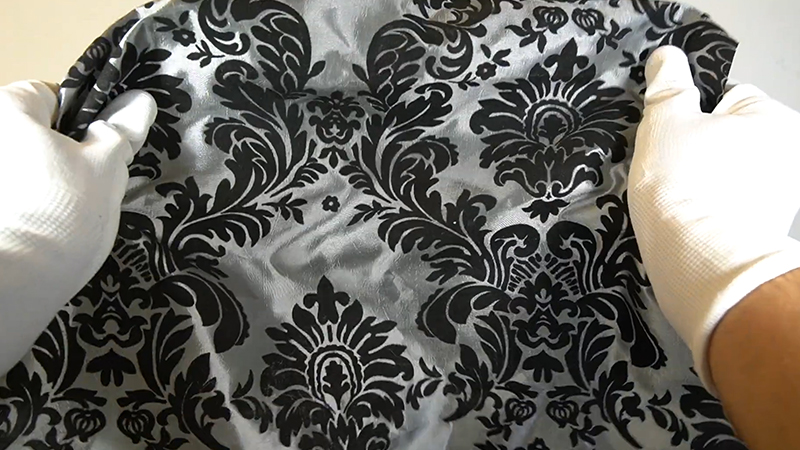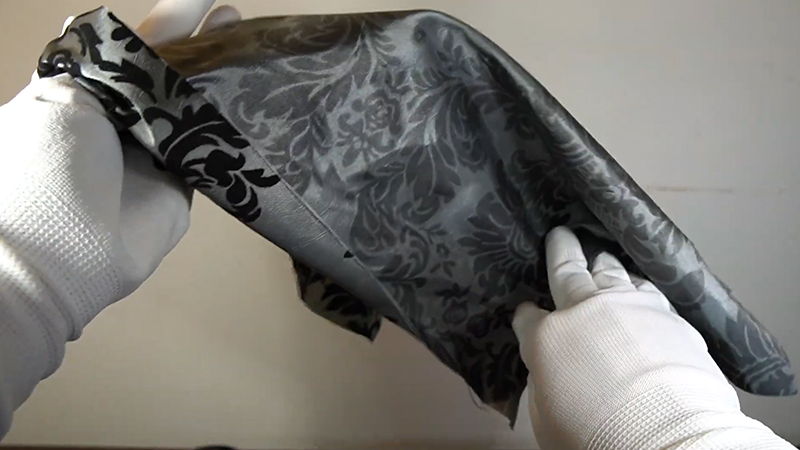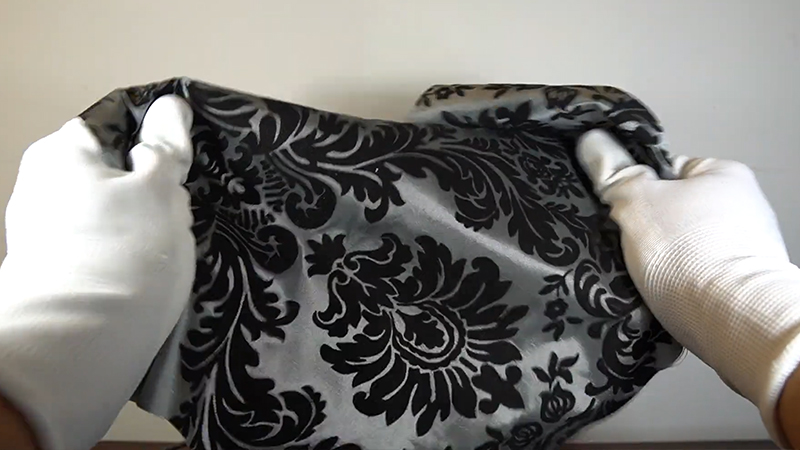
Damask fabric, renowned for its intricate and reversible patterns, holds a rich history tracing its origins to Damascus, modern-day Syria. This luxurious textile, traditionally crafted from silk, cotton, or wool, was once a symbol of opulence reserved for nobility.
Today, damask fabric has evolved, embracing synthetic fibers and modern weaving techniques, making its distinctive beauty more accessible than ever before.
From elegant eveningwear to sophisticated home décor, damask continues to captivate with its unique blend of historical grandeur and contemporary versatility, embodying a timeless appeal in the world of textiles.
Its unique composition, often a combination of warp-faced satin and weft-faced sateen weaves, contributes to its characteristic texture and visual depth.
What is Damask Fabric?
Damask fabric is a textile product named after Damascus, its city of origin. It is distinctively known for its intricate, ornate, and reversible patterns.
While initially made from silk, cotton, or wool, modern advancements have introduced synthetic damask weaves. The fabric’s composition typically involves natural or artificial fibers woven in a specific combination of warp-faced satin and weft-faced sateen weaves.
Depending on the fibers used, damask can possess reasonable breathability, varying heat retention, and is generally not stretchy, though these properties can differ significantly by material.
Damask Fabric in History
The historical journey of damask fabric is as rich and intricate as its patterns. The first mention of “damask” in Western records appeared in a 14th-century document from France, a major mercantile hub at the time.
However, historians acknowledge that damask was one of the five primary textile products of Byzantium and Arabia during their glory days, indicating its much earlier origins in the Middle East, though the exact timeline is unclear.
By the Middle Ages, damask’s popularity waned in many regions, except for Spain, which remained under Muslim occupation until the 15th century.
Throughout the Renaissance and Enlightenment periods, silk remained the most popular material for damask, often considered a luxury item due to the long distances silk had to travel from Asia to Western Europe, making it largely reserved for nobility.
Despite the predominance of silk, weavers also experimented with woolen and cotton damasks during these times.
In contemporary times, damask has experienced a shift in its status. It has lost some of its historical grandeur primarily because it is now plentiful and inexpensive to produce.
The advent of petrochemical fibers in the 20th century further contributed to its affordability and ease of sourcing. The invention of the computerized Jacquard loom was a pivotal moment, automating damask weaving and significantly reducing costs, thereby increasing its accessibility.
While damask may never regain the same level of popularity it held in the first few centuries AD, its intricate patterns remain cherished as cultural artifacts from diverse peoples and societies throughout history.
How is Damask Fabric Made?

Traditionally, the creation of damask fabric was an exceptionally challenging and time-consuming endeavor. Crafting a single damask tapestry using conventional looms could take weeks.
The process has been revolutionized by technological advancements, particularly the invention of the Jacquard loom, and even further by its computerization.
Traditional Weaving
In traditional damask weaving, a “filling” refers to each set of warp and weft yarns. A piece of damask can incorporate one or more fillings.
The weaving process involves creating both satin and sateen fields, with the warp potentially passing over as many as nine fillings. This intricate interlacing of threads is what creates the characteristic patterns.
Computerized Jacquard Loom
Modern damask production adheres to the fundamental principles of traditional weaving, but the manual labor has been replaced by robotic arms and computer programming.
The computerized Jacquard loom has largely automated the weaving process, which, while reducing the need for human weavers, has made the beauty of damask fabric widely accessible to the general public, a luxury once reserved only for the elite. This technological leap has significantly reduced production time and costs.
How is Damask Fabric Used?
The primary application for damask fabric today is in home decor, though it also finds considerable use in apparel and accessories.
Damask in Apparel
Due to its inherent rigidity, damask is not typically suited for everyday clothing. However, the development of synthetic fabrics has enabled the production of finer, more form-fitting damask.
Its main uses in fashion include eveningwear, jackets, and other relatively stiff garments designed to offer some weather resistance. The material is favored for pieces where its structured nature and elegant patterns can be fully appreciated.
Damask in Accessories
Damask is also a popular choice for various accessories, such as scarves, handbags, and luggage. For items worn close to the skin, soft fibers like silk are often preferred.
Conversely, durable synthetic fibers are commonly used for luggage and other heavy-duty damask accessories that require greater resilience.
Damask in Decor
Within the home, damask is ubiquitous, appearing in everything from curtains to upholstery to rugs. Upholstery stands out as its most common decor application, with damask couches being a familiar sight.
It is also highly popular as a material for curtains and can occasionally be found in light rugs. Its ornate patterns add a touch of sophistication to any interior space.
Pseudo-Damask
The captivating beauty of damask patterns has extended beyond textiles, inspiring numerous non-fabric products. Wallpaper is a prime example of a product category that has adopted damask patterns, applying them to surfaces other than fabric.
Additionally, damask patterns are frequently seen on items like suitcases, glasses cases, laptop cases, phone cases, and a wide array of other plastic accessories.
Where is Damask Fabric Produced?

The leading producers of damask fabric vary depending on the specific fiber used in its composition.
Largest Producer of Silk
Historically and presently, India is the world’s largest producer of silk, followed by China, which also exports a significant amount. India’s ancient mulberry groves and ancestral silkworm breeds continue to make it the dominant force in silk production.
Largest Producer of Wool
With a sheep population far exceeding its human population, Australia naturally holds the title of the world’s biggest wool producer. Consequently, most wool damask available today, and indeed most wool products in general, originate from Australia.
Largest Producer of Cotton
Currently, India is also the world’s largest producer of cotton. This position is expected to be maintained as India’s economy continues to grow while China’s contracts.
Largest Producer of Synthetic Fabric
Given its status as the world’s largest petrochemical producer, China is the epicenter of global synthetic textile fiber production. Therefore, a substantial portion of synthetic damask fabric originates from China.
How Much Does Damask Fabric Cost?
The cost of damask fabric is influenced by several key factors:
The Fabric Used
The type of fiber directly impacts the price. Silk is generally more expensive than cotton, and cotton, in turn, costs more than polyester.
Natural, organic fabrics typically command higher prices, but they are often considered worthwhile for their aesthetic appeal, feel, and reduced environmental impact.
The Number of Fillings
Single-color damask is usually less expensive than damask woven with multiple fillings or colors. The complexity added by incorporating more colors or intricate layers of warp and weft yarns increases production costs.
The Overall Weave Quality
Some traditionalists maintain that hand-woven damask is superior to machine-woven versions. Consequently, traditional, hand-woven damask can fetch a premium price, with the skill and artistry of the weaver directly influencing the cost per bolt.
High-quality, meticulously crafted weaves, whether hand- or machine-produced, generally command higher prices.
What Different Types of Damask Fabric Are There?
Damask fabric is available in several varieties, primarily distinguished by the material used and sometimes by a specific weave pattern.
Silk Damask
Considered “true damask” by purists, silk damask was the original material for this iconic patterned fabric for centuries. It remains the softest and highest-quality version, and consequently, the most expensive. Its luxurious sheen and drape are unparalleled.
Synthetic Damask
While some connoisseurs might dismiss it, damask made from non-natural fibers is now the standard. Synthetic damask offers a more affordable and often more durable alternative, making the damask pattern accessible to a broader market.
Cotton Damask
Early weavers in the East experimented with cotton damask, but it never achieved the widespread popularity of silk damask. However, it continues to be produced, offering a more breathable and accessible natural fiber option.
Wool Damask
Similar to cotton damask, wool damask has periodically captured the interest of the fashion community over the centuries. It offers warmth and a different texture, making it suitable for specific applications like upholstery and heavier garments.
Twill Damask
Twill damask can be produced using any of the aforementioned materials. Its distinguishing feature is a slightly different weave pattern that results in a distinct twill appearance, adding another dimension to the classic damask design.
How Does Damask Fabric Impact the Environment?
Since damask refers to a fabric pattern rather than a specific fiber, its direct environmental impact is primarily concentrated in the final weaving process.
However, the overall journey of a finished damask garment involves various stages, and the choices made by manufacturers at each stage significantly determine its environmental footprint.
Environmental Impact of Natural Fibers
Generally, natural fibers tend to have a less negative environmental impact. Among the natural fabrics used for damask, cotton is considered the “dirtiest”.
Its cultivation as a plant crop often necessitates the use of toxic pesticides, fertilizers, and other chemicals that can harm local plant, animal, and human communities.
In contrast, silk and wool have practically minimal negative environmental impacts. While it is possible for sheep and other wool-producing animals to be kept in poor conditions, and some manufacturers do this, there is a growing movement towards organic and sustainable animal fiber cultivation.
Environmental Impact of Synthetic Fibers
The production of synthetic fibers inevitably causes environmental damage that cannot be fully eliminated, though it can be reduced.
The early days of petrochemical-based fiber production did not anticipate the extensive environmental consequences, such as the accumulation of plastic in oceans and the broader issue of ongoing pollution amidst climate change concerns.
Synthetic fibers are derived from non-renewable resources and their manufacturing processes are typically energy-intensive.
The Impact of Manufacturing Processes
Beyond the raw materials, the subsequent manufacturing processes also profoundly influence damask’s environmental impact.
The use of toxic dyes, flame retardants, and other post-production treatments can contaminate soil, waterways, and affect human health through inhalation.
Sustainable manufacturing practices that minimize or eliminate these harmful chemicals are crucial for reducing the overall environmental footprint of damask fabric.
Damask Fabric Certifications Available
To address environmental and ethical concerns, several organizations offer certifications for damask fabric, depending on the materials used.
Global Recycle Standard (GRS)
The Global Recycle Standard (GRS) certifies companies that incorporate recycled materials into their products. In the textile industry, GRS certification primarily applies to synthetic fibers, but it can also extend to recycled wool and cellulose derived from cotton. This certification promotes a circular economy and reduces waste.
Silk Mark
Silk Mark is an Indian organization that certifies silk cultivated sustainably. This helps consumers identify silk products that have been produced with environmentally responsible and ethical practices.
Woolmark
While a wool company itself, Woolmark is also recognized as the world’s most trusted wool certifying body. This certification assures consumers of the quality, purity, and ethical sourcing of wool products, including wool damask.
In conclusion, damask fabric, with its rich history, diverse applications, and evolving production methods, continues to be a significant textile.
Understanding its origins, manufacturing, types, and impact allows for a deeper appreciation of this enduringly elegant material.





